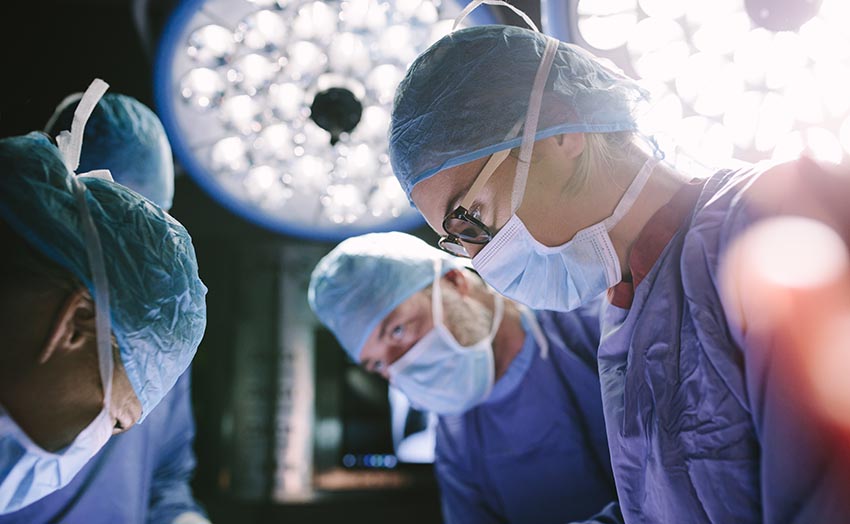
Surgical and Non Surgical Therapies
Non Surgical Therapy
Physical Therapy
The Center for Facial Nerve Disorders is staffed by specialty-trained physical therapists dedicated to facial nerve recovery and retraining. The return of facial nerve function can be unpredictable and can result in poorly coordinated facial motion. Facial physical therapy is essential for the treatment of synkinesis and hemifacial spasm. Our therapists work closely with our facial plastic surgeon to optimize facial function by coordinating stretches and exercises, biofeedback and chemodenervation such as with botulinum toxin.
Ancillary Procedures
Chemodenervation with botulinum toxin
The return of facial nerve function and muscular activity can be uncertain. At times the facial muscles can become hyperfunctional, impairing meaningful motion such as smiling. Botulinum toxin may be used to reduce muscular function that may inhibit desired motion (smiling, eye closure). Chemodenervation may also be used to balance the facial appearance and enhance symmetry.
Surgical Therapy
Facial Reanimation
Early Options
(under 2 years since injury)
Direct nerve repair
If a facial nerve is injured by a sharp force as a result of trauma, the facial nerve may be repaired directly to itself. Direct nerve repair is the most successful and simplest method of facial nerve repair.
Cable or interposition grafting
In a situation where there is a segment of nerve missing, such as in tumor surgery or severe traumatic injury, a donor nerve must be brought in to connect the gap between the separate ends of the facial nerve. Cable or interposition grafting results in meaningful improvements of facial function.
Nerve transposition
In situations where facial movement can no longer be powered by the patient’s brain telling the face to move, whereas the nerve segment closest to the brain is missing, alternate nerves can be chosen to power the facial musculature. In these situations, we use another nerve to power the facial muscles such as the masseteric nerve (cranial nerve V), the hypoglossal nerve (cranial nerve XII) or the facial nerve on the other side of the face (cranial nerve VII).
Masseter to facial nerve transposition (V-VII)
In the V-VII procedure, the facial nerve is attached to a nerve that powers a muscle of the jaw, the nerve to the masseter or cranial nerve V, to recover facial movement. The advantages of this procedure are a strong smile and some improvement of facial tone.
Hypoglossal to facial nerve transposition (XII-VII)
The XII-VII procedure has been used for many years to offer recovery to patients suffering from facial paralysis. The facial nerve is attached to part of the hypoglossal nerve (cranial nerve XII), the main motor nerve to the tongue, to power the facial musculature. The advantages of the XII-VII are a nice return of facial tone with some directed movement and for many, a good smile.
Cross face nerve grafting
The facial nerve on the normal side can be used to improve the function of the reanimated side or to power other nerve grafts or flaps such as in the gracilis free tissue transfer (see below)
Dual Innervation Techniques
Some of the newer procedures for facial reanimation involve the use of multiple nerves for improvement of facial function. Our highly trained surgeons are now performing procedures utilizing both the nerve to the masseter or cranial nerve V with the hypoglossal nerve, or cranial nerve XII. Our early outcomes offer improvements in both smile and overall facial tone.
Chronic Facial Nerve Paralysis Options
(greater than 2 years since injury)
Muscle transposition
Temporalis muscle
The temporalis muscle may be used in multiple ways to reanimate the paralyzed face. It has replaced the used of the masseter muscle as a regional option to facial reanimation for a couple of reasons, most notably the direction of pull of the temporalis muscle more closely mimics the muscles used when smiling. The temporalis muscle can be used as a dynamic option for the paralyzed eye as well as the mouth and smile. More recently, the orthodromic temporalis tendon transfer is performed with great success when a patient is not a candidate for a more formal nerve transposition but would like some reanimation options.
Free Tissue Transfer
Gracilis free tissue transfer is used in our patients with longer standing facial paralysis. In this situation, the muscles of the face are no longer viable and outside muscle must be transplanted. The gracilis muscle is harvested from the inner thigh, with its corresponding nerve, and transplanted to the face to allow for reanimation of the smile.
Static Adjunct Procedures
Static Sling
Static support of the facial tissues can be performed with several different materials. Often a tendon from the outer thigh may be used, fascia lata, to support the corner of the mouth and nose. Less frequently, gortex or alloderm (cadaveric dermis) may be used as well. This procedure will not offer motion, hence the word static, however, can benefit our older population unable to go through a larger nerve surgery.
Platinum weight insertion
For the paralyzed eye struggling with protection and lubrication following facial paralysis, a platinum weight may be inserted within the upper eyelid. Platinum is now used over the previously popular gold weight as platinum is 11% denser allowing for a physically smaller weight resulting in less risk of extrusion.
Lid tightening procedures
The lower eyelid may suffer from laxity related to facial paralysis. The lower lid may hang forward and down, also called an ectropion, resulting in tear collection and complaints of a watery eye. Tightening of the lower lid may offer improved comfort, also reducing watering and dryness.
Facelift/midface lift
Our patients with a severe facial droop may benefit from a facelift on the affected side to re-support the soft tissues of the paralyzed face.
Cheiloplasty
Support of the lower lip in facial paralysis can be problematic. There are a couple of main procedures we can perform to improve symmetry such as a wedge resection of the lower lip as well as a cheiloplasty. Often balancing these procedures with botulinum toxin on the nonparalyzed side is most beneficial.
